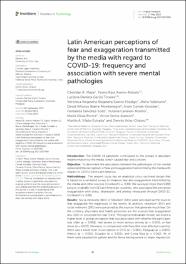| dc.contributor.author | Mejia, Christian R. | |
| dc.contributor.author | Aveiro-Róbalo, Telmo Raul | |
| dc.contributor.author | Garlisi Torales, Luciana Daniela | |
| dc.contributor.author | Castro Hidalgo, Verónica Alejandra Alejandra | |
| dc.contributor.author | Valeriano, Jhino | |
| dc.contributor.author | Ibarra-Montenegro, David Alfonso | |
| dc.contributor.author | Conde-Escobar, Aram | |
| dc.contributor.author | Sánchez-Soto, Fernanda | |
| dc.contributor.author | Canaviri-Murillo, Yuliana | |
| dc.contributor.author | Oliva-Ponce, María | |
| dc.contributor.author | Serna-Alarcón, Victor | |
| dc.contributor.author | Vilela-Estrada, Martín A. | |
| dc.contributor.author | Arias-Chávez, Dennis | |
| dc.date.accessioned | 2023-09-18T19:38:19Z | |
| dc.date.available | 2023-09-18T19:38:19Z | |
| dc.date.issued | 2023-05-17 | |
| dc.identifier.uri | https://hdl.handle.net/20.500.13053/9369 | |
| dc.description.abstract | “Introduction: The COVID-19 pandemic contributed to the spread of abundant misinformation by the media, which caused fear and concern.
Objective: To determine the association between the pathologies of the mental sphere and the perceptions of fear and exaggeration transmitted by the media with respect to COVID-19 in Latin America.
Methodology: The present study has an analytical cross-sectional design that is based on a validated survey to measure fear and exaggeration transmitted by the media and other sources (Cronbach's α: 0.90). We surveyed more than 6,000 people, originally from 12 Latin American countries, who associated this perceived exaggeration with stress, depression, and anxiety (measured through DASS-21, Cronbach's α: 0.96).
Results: Social networks (40%) or television (34%) were perceived as the sources that exaggerate the magnitude of the events. In addition, television (35%) and social networks (28%) were perceived as the sources that generate much fear. On the contrary, physicians and health personnel are the sources that exaggerated less (10%) or provoked less fear (14%). Through a multivariate model, we found a higher level of global perception that was associated with whether the participant was older (p = 0.002), had severe or more serious anxiety (p = 0.033), or had stress (p = 0,037). However, in comparison with Peru (the most affected country), there was a lower level of perception in Chile (p < 0.001), Paraguay (p = 0.001), Mexico (p < 0.001), Ecuador (p = 0.001), and Costa Rica (p = 0.042). All of them were adjusted for gender and for those having severe or major depression.
Conclusion: There exists an association between some mental pathologies and the perception that the media does not provide moderate information.“ | es_PE |
| dc.format | application/pdf | es_PE |
| dc.language.iso | eng | es_PE |
| dc.publisher | Frontiers Media S.A. | es_PE |
| dc.rights | info:eu-repo/semantics/openAccess | es_PE |
| dc.rights.uri | https://creativecommons.org/licenses/by/4.0/ | es_PE |
| dc.subject | The COVID-19 pandemic, study conducted | es_PE |
| dc.title | Latin American perceptions of fear and exaggeration transmitted by the media with regard to COVID-19: frequency and association with severe mental pathologies | es_PE |
| dc.type | info:eu-repo/semantics/article | es_PE |
| dc.identifier.doi | https://doi.org/10.3389/fpsyg.2023.1037450 | |
| dc.type.version | info:eu-repo/semantics/publishedVersion | es_PE |
| dc.publisher.country | CHE | es_PE |
| dc.subject.ocde | 3.03.00 -- Ciencias de la salud | es_PE |


